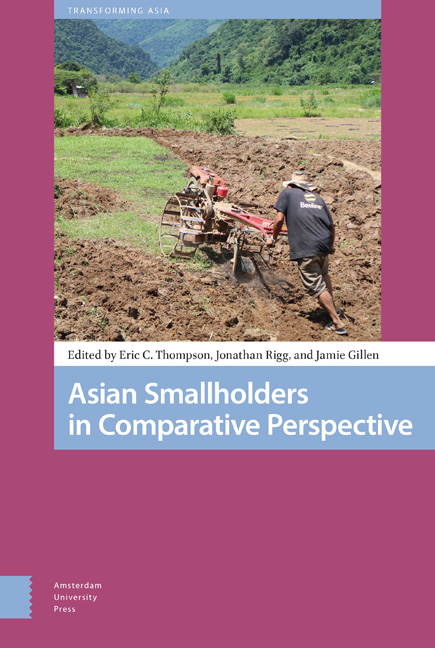Book contents
- Frontmatter
- Contents
- List of Maps, Figures and Tables
- Preface
- Introduction: Asian Smallholders in Comparative Perspective
- 1 Cambodia: Political Strife and Problematic Land Tenure
- 2 Indonesia: Whither Involution, Demographics, and Development?
- 3 Japan: Government Interventions and Part-time Family Farming
- 4 Laos: Responding to Pressures and Opportunities
- 5 Malaysia: The State of/in Village Agriculture
- 6 The Philippines: Fragmented Agriculture , Aquaculture, and Vulnerable Livelihoods
- 7 Singapore: Making Space for Farming
- 8 Taiwan: Toward the Revitalization of Smallholder Agriculture
- 9 Thailand: The Political Economy of Post-Peasant Agriculture
- 10 Vietnam: From Socialist Transformation to Reform
- Index
3 - Japan: Government Interventions and Part-time Family Farming
Published online by Cambridge University Press: 21 November 2020
- Frontmatter
- Contents
- List of Maps, Figures and Tables
- Preface
- Introduction: Asian Smallholders in Comparative Perspective
- 1 Cambodia: Political Strife and Problematic Land Tenure
- 2 Indonesia: Whither Involution, Demographics, and Development?
- 3 Japan: Government Interventions and Part-time Family Farming
- 4 Laos: Responding to Pressures and Opportunities
- 5 Malaysia: The State of/in Village Agriculture
- 6 The Philippines: Fragmented Agriculture , Aquaculture, and Vulnerable Livelihoods
- 7 Singapore: Making Space for Farming
- 8 Taiwan: Toward the Revitalization of Smallholder Agriculture
- 9 Thailand: The Political Economy of Post-Peasant Agriculture
- 10 Vietnam: From Socialist Transformation to Reform
- Index
Summary
Abstract
This chapter reviews pertinent issues facing Japanese smallholders and explores the role of small-scale farming households in contemporary Japan. Here, the influences of agricultural policy and technological innovations on smallholders are considered alongside reviews of key regional differences in Japanese agriculture, based on geographical terrain, management scale and labour force organization. Research reveals that the small-scale nature of household farms, ageing, and a lack of successors are some of the major factors – among others – threatening the persistence of smallholder agriculture in Japan.
Keywords: ageing, depopulation, Gentan Seisaku (Acreage Reduction Policy), industrialization, Japan, part-time family farming, rice farming
According to the Ministry of Agriculture, Forestry, and Fisheries, Japan’s self-sufficiency in grains stands at only 29% because of wheat and feed grain imports. Despite this deficiency, the self-sufficiency rate of rice maintains at 95%. Part-time family farms continue to play a large role in rice production. The 2010 World Census of Agriculture and Forestry in Japan reports that the average paddy-holding size of Japanese farming households which produce rice was only 1.43 ha. Thus, the farm size of most Japanese farming households is small-scale. In this chapter we highlight the particular issues faced by Japanese smallholders and clarify their socio-economic and cultural position in Japan. The position of smallholder family farms has been strongly shaped by government policies over more than fifty years, since the postwar period.
During the war, the Staple Food Control Law of 1942 was enacted to solve serious food shortages and increase farmers’ motivation to produce more rice. Essentially, the government would purchase rice at the highest price from the producers (the producers’ rice price) and sell it at the cheapest price to the consumers (consumers’ rice price). As a result of the law, rice production was greatly increased as intended and Japan was able to successfully solve its food shortage.
In the postwar period, the government passed the Agricultural Basic Law of 1961, “Jiritsu Keiei no Ikusei ” (Nurturing Viable Farms) with its primary objective of accomplishing the modernization of agriculture. At the time the Agricultural Basic Law was enacted, income disparities between urban and rural areas as well as the agricultural and industrial sectors had been exacerbated by the advancement of urbanization and industrialization during the postwar period of high economic growth (Tashiro 1999).
- Type
- Chapter
- Information
- Asian Smallholders in Comparative Perspective , pp. 81 - 108Publisher: Amsterdam University PressPrint publication year: 2019



